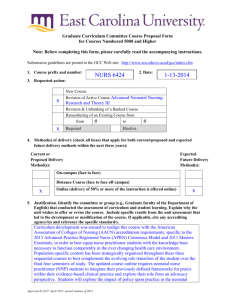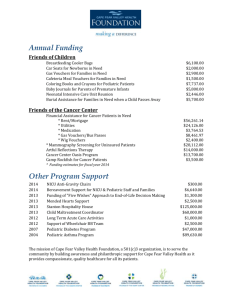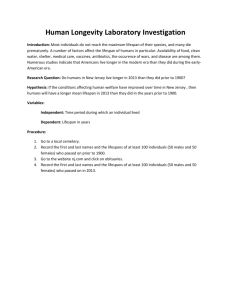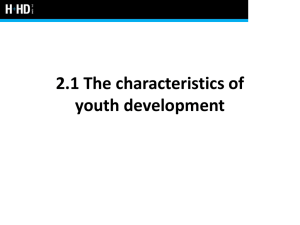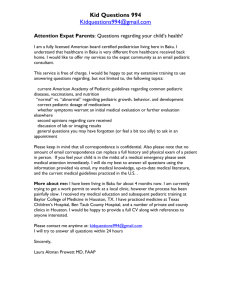NURS 6419
advertisement
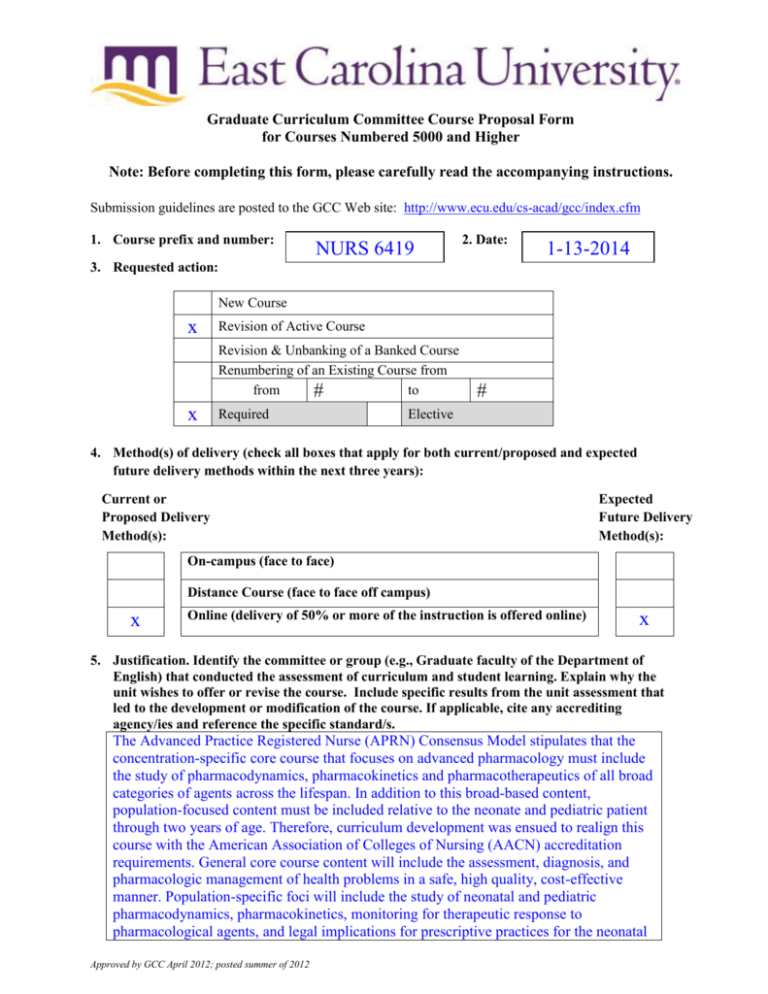
Graduate Curriculum Committee Course Proposal Form for Courses Numbered 5000 and Higher Note: Before completing this form, please carefully read the accompanying instructions. Submission guidelines are posted to the GCC Web site: http://www.ecu.edu/cs-acad/gcc/index.cfm 1. Course prefix and number: NURS 6419 2. Date: 1-13-2014 3. Requested action: New Course x Revision of Active Course Revision & Unbanking of a Banked Course Renumbering of an Existing Course from from to # x Required # Elective 4. Method(s) of delivery (check all boxes that apply for both current/proposed and expected future delivery methods within the next three years): Current or Proposed Delivery Method(s): Expected Future Delivery Method(s): On-campus (face to face) Distance Course (face to face off campus) x Online (delivery of 50% or more of the instruction is offered online) x 5. Justification. Identify the committee or group (e.g., Graduate faculty of the Department of English) that conducted the assessment of curriculum and student learning. Explain why the unit wishes to offer or revise the course. Include specific results from the unit assessment that led to the development or modification of the course. If applicable, cite any accrediting agency/ies and reference the specific standard/s. The Advanced Practice Registered Nurse (APRN) Consensus Model stipulates that the concentration-specific core course that focuses on advanced pharmacology must include the study of pharmacodynamics, pharmacokinetics and pharmacotherapeutics of all broad categories of agents across the lifespan. In addition to this broad-based content, population-focused content must be included relative to the neonate and pediatric patient through two years of age. Therefore, curriculum development was ensued to realign this course with the American Association of Colleges of Nursing (AACN) accreditation requirements. General core course content will include the assessment, diagnosis, and pharmacologic management of health problems in a safe, high quality, cost-effective manner. Population-specific foci will include the study of neonatal and pediatric pharmacodynamics, pharmacokinetics, monitoring for therapeutic response to pharmacological agents, and legal implications for prescriptive practices for the neonatal Approved by GCC April 2012; posted summer of 2012 nurse practitioner. 6. Course description exactly as it should appear in the next catalog: NURS 6419 – Clinical Pharmacology for Advanced Nursing Practice Across the Lifespan 3 May be repeated upon readmission to the concentration. P: Admission to NURS graduate program or consent of instructor. Scientific inquiry relative to the pharmacodynamics, pharmacokinetics and pharmacotherapeutics of broad categories of agents across the lifespan, with emphasis on the neonate and pediatric patient. 7. If this is a course revision, briefly describe the requested change: Revisions to course name, course description, topical outline, and required textbooks. 8. Course credit: Lecture Hours 3 3 Weekly OR Per Term Credit Hours Lab Weekly OR Per Term Credit Hours s.h. Studio Weekly OR Per Term Credit Hours s.h. Practicum Weekly OR Per Term Credit Hours s.h. Internship Weekly OR Per Term Credit Hours s.h. Other (e.g., independent study) Please explain. s.h. 3 Total Credit Hours 9. Anticipated annual student enrollment: 18 10. Changes in degree hours of your programs: Degree(s)/Program(s) Changes in Degree Hours MSN Neonatal Nurse Practitioner none 11. Affected degrees or academic programs, other than your programs: Degree(s)/Program(s) Changes in Degree Hours n/a n/a 12. Overlapping or duplication with affected units or programs: x Not applicable Documentation of notification to the affected academic degree programs is attached. 13. Council for Teacher Education (CTE) approval (for courses affecting teacher education): x Not applicable Approved by GCC April 2012; posted summer of 2012 s.h. s.h. Applicable and CTE has given their approval. 14. University Service-Learning Committee (USLC) approval: x Not applicable Applicable and USLC has given their approval. 15. Statements of support: a. Staff x Current staff is adequate Additional staff is needed (describe needs in the box below): b. Facilities x Current facilities are adequate Additional facilities are needed (describe needs in the box below): c. Library x Initial library resources are adequate Initial resources are needed (in the box below, give a brief explanation and an estimate for the cost of acquisition of required initial resources): d. Unit computer resources x Unit computer resources are adequate Additional unit computer resources are needed (in the box below, give a brief explanation and an estimate for the cost of acquisition): e. ITCS resources x ITCS resources are not needed The following ITCS resources are needed (put a check beside each need): Mainframe computer system Statistical services Network connections Computer lab for students Software Approval from the Director of ITCS attached 16. Course information (see: Graduate Curriculum and Program Development Manual for instructions): a. Textbook(s) and/or readings: author(s), name, publication date, publisher, and city/state/country. Include ISBN (when applicable). Approved by GCC April 2012; posted summer of 2012 Required Text Books American Psychological Society. (2009). Publication manual of the American Psychological Society (6th ed.). Washington, DC: Author. ISBN# 9781433805615 Yaffe, S. J., & Aranda, J. V. (Eds.). (2011). Neonatal and pediatric pharmacology: therapeutic principles in practice (4th ed.). Philadelphia, PA: Lippincott Williams & Wilkins. ISBN# 9780781795388 Taketomo, C.K., Hodding, J.H., Kraus, D.M. (2013-2014). Pediatric & neonatal dosage handbook (20th ed.). Hudson, OH: Lexicomp. ISBN# 9780916589448 b. Course objectives for the course (student – centered, behavioral focus) If this is a 5000-level course that is populated by undergraduate and graduate students, there must be differentiation in the learning objectives expected. Upon completion of this course, students will be able to: 1. Apply the principles of pharmacokinetics and pharmacodynamics in selecting pharmacologic therapies across the lifespan, with emphasis on neonates and pediatric patients up to two years of age. 2. Analyze the relationship between pharmacologic agents and physiologic/pathologic responses in patients with specific acute and chronic health problems across the lifespan with emphasis on neonates and pediatric patients up to two years of age. 3. Evaluate the effects of single and multiple drug regimens including drug interactions and adverse drug reactions. 4. Identify pharmacological regimens for the management of common health problems affecting neonates and pediatric patients with consideration for patient variations, safety, efficacy, standard of care, cost-effectiveness and the family unit. 5. Discuss the legal parameters and standards of care when prescribing, administering, and monitoring pharmacological interventions. 6. Investigate the Centers for Disease Control recommendations for immunizations across the lifespan. c. Course topic outline The list of topics should reflect the stated objectives. I. II. III. IV. Prescriptive Authority for the Advanced Practice Nurse (Obj. 4, 5) a. Legal parameters b. Standards of care for prescribing and administering pharmacological interventions c. Prescribing and record keeping practices, per State and Federal regulations and the advanced practice nurse collaborative practice agreement d. Cost-effectiveness, safety, and efficacy: “Primum Non Nocere” Principles of pharmacodynamics across the lifespan (Obj. 1) Principles of pharmacokinetics across the lifespan (Obj. 1) a. Absorption, distribution, metabolism, and excretion Fundamentals of pharmacological interventions (Obj. 1, 4, 5) Approved by GCC April 2012; posted summer of 2012 V. VI. a. Interactions, reactions, side effects, incompatibilities, indications, and contraindications b. The effect of pharmacologic interventions on the family unit c. Considering safety, efficacy, standard of care, and cost Population-Specific Content: the neonate, pediatric patient and implications for families (as appropriate) (Obj. 1, 2, 3, 4, 5) a. Drug absorption: oral, topical, intramuscular b. Drug distribution c. Drug metabolism: the impact of acceptor proteins d. Drug elimination: first-order kinetics e. Pregnancy and pharmacology: The impact of maternal ingestion of drugs on the fetus and neonate f. Antenatal corticosteroids g. Pharmacologic agents and neonatal resuscitation h. Pharmacological regimens with investigation of physiologic/pathologic responses, single and multi-drug regimens, and safety, efficacy, standards of practice and cost-effectiveness. i. Central Nervous System: methylxanthines, anti-epileptics, muscle relaxants ii. Respiratory System: Surfactant, Nitric Oxide, Vitamin A, Bronchodilators, diuretic therapy, corticosteroids iii. Cardiovascular System: Sildenafil, inotropic agents, antiarrhythmic agents, non-steroidal anti-inflammatory drugs, alprostadil iv. Gastrointestinal System: histamine receptor agonists, proton pump inhibitors, prokinetics Infectious Diseases and Pharmacologic/Preventative Strategies: Integrating physiology and pathology in the selection, implementation, and evaluation of efficacy with pharmacologic interventions (Obj. 1, 2, 3, 4, 5, 6) a. CDC recommended immunization schedule across the lifespan: legal implications for parental refusal of childhood immunizations b. Treatment of common bacterial infections c. Neonatal eye infections d. Fungal infections e. Viral infections d. List of course assignments, weighting of each assignment, and grading/evaluation system for determining a grade MSN Essentials Reflective Statement……………………………………....5% Discussion Board Participation…………..…………………………….…..10% Case Study……..……………….………..………………………………....20% Unit Quizzes (3 quizzes, each worth 10%)……….………….…………….30% Final Exam…...…………………..………………………………………...35% TOTAL: 100% Approved by GCC April 2012; posted summer of 2012 Grading: A course grade of B or above is required to progress in the NNP concentration 100-90%....................A 89.9-80%...................B 79.9-70%...................C 69.9-0%.....................F Approved by GCC April 2012; posted summer of 2012

